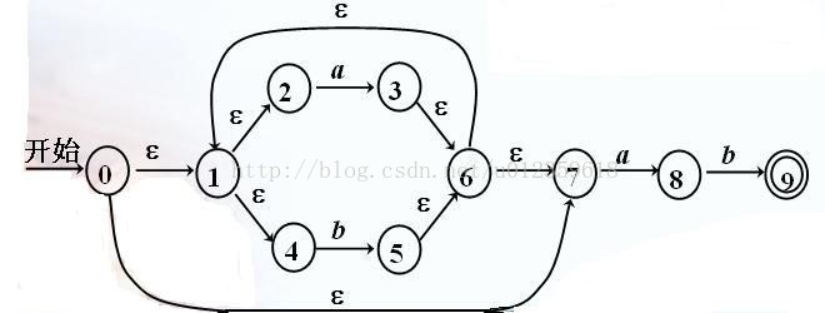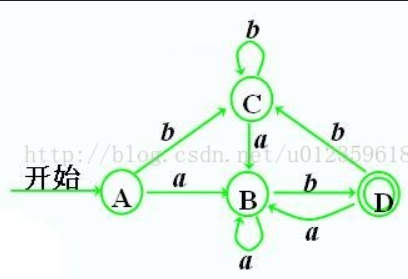NFA到DFA的轉化(保證能講明白)
如何將下圖的NFA轉化為DFA呢?

圖1
解答如下:
- 求出
ε
_
c
l
o
s
u
r
e
(
s
)
ε\_closure(s)
ε_closure(s)
ε _ c l o s u r e ( s ) ε\_closure(s) ε_closure(s)表示由狀態 s s s 經由條件 ε ε ε 可以到達的所有狀態的集合
ε _ c l o s u r e ( 0 ) = { 0 , 1 , 2 , 4 , 7 } ε\_closure(0)=\{0,1,2,4,7\} ε_closure(0)={0,1,2,4,7}
ε _ c l o s u r e ( 1 ) = { 1 , 2 , 4 } ε\_closure(1)=\{1,2,4\} ε_closure(1)={1,2,4}
ε _ c l o s u r e ( 2 ) = { 2 } ε\_closure(2)=\{2\} ε_closure(2)={2}
ε _ c l o s u r e ( 3 ) = { 1 , 2 , 3 , 4 , 6 , 7 } ε\_closure(3)=\{1,2,3,4,6,7\} ε_closure(3)={1,2,3,4,6,7}
ε _ c l o s u r e ( 4 ) = { 4 } ε\_closure(4)=\{4\} ε_closure(4)={4}
ε _ c l o s u r e ( 5 ) = { 1 , 2 , 4 , 5 , 6 , 7 } ε\_closure(5)=\{1,2,4,5,6,7\} ε_closure(5)={1,2,4,5,6,7}
ε _ c l o s u r e ( 6 ) = { 1 , 2 , 4 , 6 , 7 } ε\_closure(6)=\{1,2,4,6,7\} ε_closure(6)={1,2,4,6,7}
ε _ c l o s u r e ( 7 ) = { 7 } ε\_closure(7)=\{7\} ε_closure(7)={7}
ε _ c l o s u r e ( 8 ) = { 8 } ε\_closure(8)=\{8\} ε_closure(8)={8}
ε _ c l o s u r e ( 9 ) = { 9 } ε\_closure(9)=\{9\} ε_closure(9)={9}
- 下面的A,B,C…表示一種狀態。如A表示 { 0 , 1 , 2 , 4 , 7 } \{0,1,2,4,7\} {0,1,2,4,7},其實就是 ε _ c l o s u r e ( 0 ) ε\_closure(0) ε_closure(0)
為了讀懂下面的內容,在這裡先解釋幾個東西。
- ε _ c l o s u r e ( m o v e ( A , a ) ) ε\_closure(move(A,a)) ε_closure(move(A,a)) 中的 m o v e ( A , a ) move(A,a) move(A,a)是什麼意思呢?
它代表從狀態A,經過a到達的狀態。
A狀態是 ε _ c l o s u r e ( 0 ) = { 0 , 1 , 2 , 4 , 7 } ε\_closure(0) = \{0,1,2,4,7\} ε_closure(0)={0,1,2,4,7},在 { 0 , 1 , 2 , 4 , 7 } \{0,1,2,4,7\} {0,1,2,4,7}裡面,對每一個元素都考慮其是否通過a到達了某個狀態,觀察一下圖1,只有狀態2和7經過了a,分別到達了3和8,所以 m o v e ( A , a ) move(A,a) move(A,a) = { 3 , 8 } \{3,8\} {3,8},從而有 ε _ c l o s u r e ( m o v e ( A , a ) ) = ε _ c l o s u r e ( { 3 , 8 } ) = { 1 , 2 , 3 , 4 , 6 , 7 , 8 } ε\_closure(move(A,a)) = ε\_closure(\{3,8\}) = \{1,2,3,4,6,7,8\} ε_closure(move(A,a))=ε_closure({3,8})={1,2,3,4,6,7,8}, { 1 , 2 , 3 , 4 , 6 , 7 , 8 } \{1,2,3,4,6,7,8\} {1,2,3,4,6,7,8}是未出現過的狀態,所以可把它取名為B狀態(其它名字也行).- ε _ c l o s u r e ( { 3 , 8 } ) = { 1 , 2 , 3 , 4 , 6 , 7 , 8 } ε\_closure(\{3,8\}) = \{1,2,3,4,6,7,8\} ε_closure({3,8})={1,2,3,4,6,7,8}是怎麼來的呢?
因為在步驟1我們已經知道, ε _ c l o s u r e ( 3 ) = { 1 , 2 , 3 , 4 , 6 , 7 } ε\_closure(3)=\{1,2,3,4,6,7\} ε_closure(3)={1,2,3,4,6,7}, ε _ c l o s u r e ( 8 ) = { 8 } ε\_closure(8)=\{8\} ε_closure(8)={8} ,然後取它們的並集就得到了 { 1 , 2 , 3 , 4 , 6 , 7 , 8 } \{1,2,3,4,6,7,8\} {1,2,3,4,6,7,8}.
這樣應該解釋明白了。繼續往下看,然後不懂的話再倒回來看看。
ε _ c l o s u r e ( 0 ) = { 0 , 1 , 2 , 4 , 7 } = A ε\_closure(0) = \{0,1,2,4,7\} = A ε_closure(0)={0,1,2,4,7}=A
ε _ c l o s u r e ( m o v e ( A , a ) ) = ε _ c l o s u r e ( { 3 , 8 } ) = { 1 , 2 , 3 , 4 , 6 , 7 , 8 } = B ε\_closure(move(A,a)) = ε\_closure(\{3,8\}) = \{1,2,3,4,6,7,8\} = B ε_closure(move(A,a))=ε_closure({3,8})={1,2,3,4,6,7,8}=B
ε _ c l o s u r e ( m o v e ( A , b ) ) = ε _ c l o s u r e ( 5 ) = { 1 , 2 , 4 , 5 , 6 , 7 } = C ε\_closure(move(A,b)) = ε\_closure(5) = \{1,2,4,5,6,7\} = C ε_closure(move(A,b))=ε_closure(5)={1,2,4,5,6,7}=C
ε _ c l o s u r e ( m o v e ( B , a ) ) = ε _ c l o s u r e ( { 3 , 8 } ) = { 1 , 2 , 3 , 4 , 6 , 7 , 8 } = B ε\_closure(move(B,a)) = ε\_closure(\{3,8\}) = \{1,2,3,4,6,7,8\} = B ε_closure(move(B,a))=ε_closure({3,8})={1,2,3,4,6,7,8}=B
ε _ c l o s u r e ( m o v e ( B , b ) ) = ε _ c l o s u r e ( { 5 , 9 } ) = { 1 , 2 , 4 , 5 , 6 , 7 , 9 } = D ε\_closure(move(B,b)) = ε\_closure(\{5,9\}) =\{1,2,4,5,6,7,9\} = D ε_closure(move(B,b))=ε_closure({5,9})={1,2,4,5,6,7,9}=D
ε _ c l o s u r e ( m o v e ( C , a ) ) = ε _ c l o s u r e ( ) ε\_closure(move(C,a)) = ε\_closure() ε_closure(move(C,a))=ε_closure()
ε _ c l o s u r e ( m o v e ( C , b ) ) = ε _ c l o s u r e ( 5 ) = { 1 , 2 , 4 , 5 , 6 , 7 } = C ε\_closure(move(C,b)) = ε\_closure(5) = \{1,2,4,5,6,7\} = C ε_closure(move(C,b))=ε_closure(5)={1,2,4,5,6,7}=C
ε _ c l o s u r e ( m o v e ( D , a ) ) = ε _ c l o s u r e ( { 3 , 8 } ) = { 1 , 2 , 3 , 4 , 6 , 7 , 8 } = B ε\_closure(move(D,a)) = ε\_closure(\{3,8\}) = \{1,2,3,4,6,7,8\} = B ε_closure(move(D,a))=ε_closure({3,8})={1,2,3,4,6,7,8}=B
ε _ c l o s u r e ( m o v e ( D , b ) ) = ε _ c l o s u r e ( 5 ) = { 1 , 2 , 4 , 5 , 6 , 7 } = C ε\_closure(move(D,b)) = ε\_closure(5) = \{1,2,4,5,6,7\} = C ε_closure(move(D,b))=ε_closure(5)={1,2,4,5,6,7}=C
- 畫出DFA狀態轉換表
步驟2中有A,B,C,D四種情況,其中A是初始情況( ε _ c l o s u r e ( 0 ) = { 0 , 1 , 2 , 4 , 7 } ε\_closure(0)=\{0,1,2,4,7\} ε_closure(0)={0,1,2,4,7}. 多說幾句,在NFA圖1中,是從0出發的,所以初始情況是 ε _ c l o s u r e ( 0 ) ε\_closure(0) ε_closure(0),那假設如果是從X開始,則初始情況是 ε _ c l o s u r e ( X ) ε\_closure(X) ε_closure(X))
看步驟2, ε _ c l o s u r e ( m o v e ( A , a ) ) = ε _ c l o s u r e ( { 3 , 8 } ) = { 1 , 2 , 3 , 4 , 6 , 7 , 8 } = B ε\_closure(move(A,a)) = ε\_closure(\{3,8\}) = \{1,2,3,4,6,7,8\} = B ε_closure(move(A,a))=ε_closure({3,8})={1,2,3,4,6,7,8}=B,所以A行a列填B,其他同理。
| a | b | |
|---|---|---|
| A | B | C |
| B | B | D |
| C | B | C |
| D | B | C |
- 根據DFA狀態轉換表畫出DFA狀態轉換圖

看步驟3的表格,A經過a到B,A經過b到C,B經過a到B,以此類推…
參考:
NFA到DFA的轉化🔗